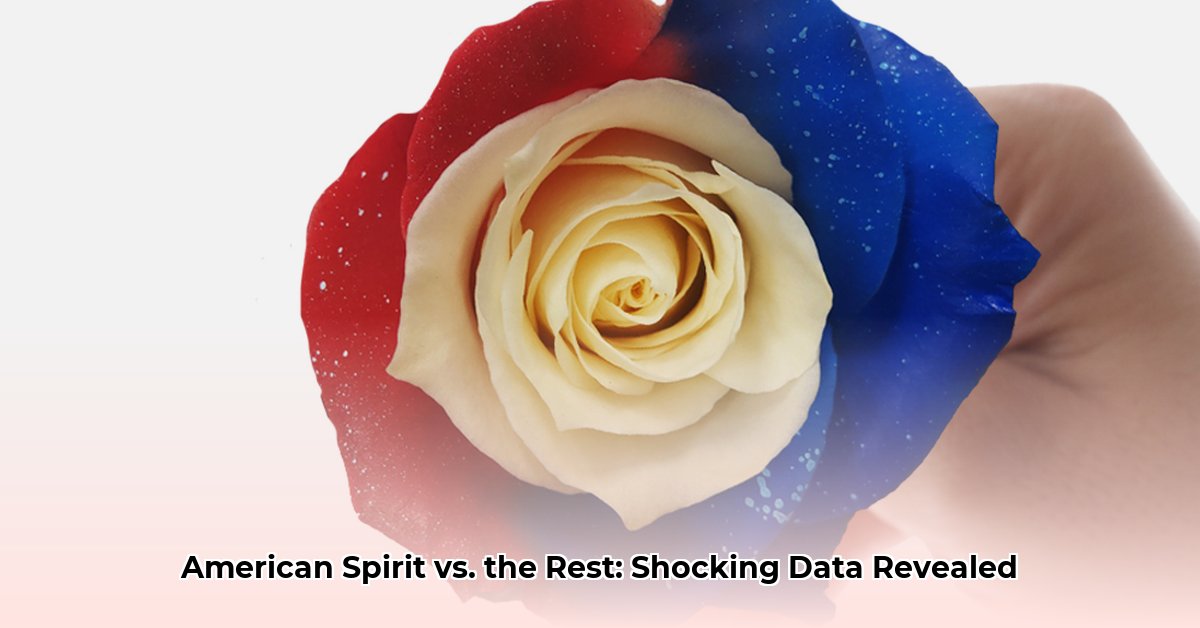Many smokers believe that “natural” cigarettes, like American Spirit, are healthier. But is that really the case? This article takes a close look at American Spirit and compares it to other brands, using data to distinguish myths from reality. We’ll examine what “natural” and “organic” mean in the cigarette industry, considering factors like nicotine and tar levels and their effects on health. We’ll analyze the marketing claims and provide you with the information needed to make informed decisions about your smoking habits. For a detailed comparison, see this American Spirit vs. Marlboro analysis. This isn’t about opinions; it’s about the evidence that matters.
Comparing American Spirit to Other Brands: A Data-Driven Analysis
Let’s examine American Spirit cigarettes. They’re frequently promoted as “natural,” suggesting they’re a healthier choice. But is this accurate? We’ll explore the evidence to compare American Spirit to other brands and see what the facts reveal. Many smokers believe “natural” means safer, but is this simply marketing, or is there more to it? How do different tar levels affect the health risks for smokers?
Debunking the “Natural” Myth: Are American Spirit Cigarettes Really Different?
American Spirit’s marketing highlights its “natural” qualities, implying they’re easier on your lungs. But the reality is more complex. Many smokers believe this, but independent tests often show a different story. Let’s compare American Spirit to other brands and uncover the truth. What are the key differences in manufacturing processes between “natural” and conventional cigarettes?
It’s easy to believe “natural” means healthier. However, this can be misleading. While these cigarettes may lack artificial additives, the primary danger – burning tobacco – remains. Even if the tobacco is “organic,” burning it still creates harmful chemicals. The health risks associated with smoking are still significant, regardless of whether you’re smoking “natural” or regular cigarettes. How do combustion byproducts differ between organic and traditional cigarettes?
Nicotine: The Addictive Substance
One critical aspect to consider when comparing brands like American Spirit is nicotine. It’s the addictive substance in cigarettes, and higher levels make quitting harder. The amounts vary depending on the cigarette type and tobacco, but American Spirit cigarettes often have nicotine content comparable to, or higher than, many other major brands. Nicotine levels can even vary within the American Spirit range, which raises questions about consistent quality. What is the relationship between menthol cigarettes and nicotine addiction?
Here’s a look at some typical nicotine levels, it is important to know the exact milligrams of nicotine that you are consuming:
| Brand | Approximate Nicotine (mg/cigarette) | Approximate Tar (mg/cigarette) | Important Notes |
|---|---|---|---|
| American Spirit (Yellow) | 2.8 | Not Specified | Nicotine levels can vary. |
| American Spirit (Blue) | 3.4 | Not Specified | Nicotine levels can vary |
| American Spirit (Dark Green Menthol) | 4.4 | Not Specified | Nicotine levels can vary |
| Marlboro Red | 1.2 | Not Specified | Levels can vary |
| Camel Filters | 1.2 | Not Specified | Levels can vary |
| Newport Menthol | 1.5 | Not Specified | Levels can vary |
(Note: these values can vary. Always check the specific product information.)
Beyond Nicotine: The Broader Impact of Harmful Chemicals
It’s not just nicotine that’s a concern. Burning tobacco creates a cocktail of harmful chemicals, regardless of artificial additives. American Spirit’s marketing focuses on lacking artificial ingredients, but burning tobacco is harmful to your health. Long-term health risks associated with smoking are a major concern, no matter the brand. How does the presence of humectants in cigarettes impact the formation of harmful chemicals during smoking?
Regulatory Scrutiny and Marketing Tactics
American Spirit’s “natural” claims have attracted attention from regulatory bodies like the FDA. Their marketing has faced scrutiny, underscoring the need for consumers to be cautious about what’s printed on cigarette packs. Terms like “natural” can create a false sense of security, especially for those seeking a supposedly less harmful cigarette. How has American Spirit responded to FDA regulations regarding its marketing practices?
Making Informed Choices: A Call to Action
It’s important to understand the reality of what “natural” means regarding cigarettes. The evidence suggests that any health advantages of American Spirit are minimal. All cigarette brands carry significant health risks. The best choice is to quit smoking, but if that’s not possible, being informed is crucial. Always consult reliable sources and research before choosing a cigarette brand. Comparing different brands is part of the process, but remember that avoiding smoking altogether is the safest option. Where can smokers find resources for quitting smoking?
Comparing Nicotine Levels in Different Cigarette Brands
Key Takeaways:
- Despite “natural” marketing, American Spirit cigarettes often contain comparable or higher nicotine levels than other major brands.
- Direct comparisons are difficult due to the lack of consistent, large-scale studies comparing nicotine levels across all brands.
- Marketing claims around “natural” ingredients can be misleading and influence consumer perceptions of risk.
Decoding the “Natural” Claim: American Spirit Under the Microscope
American Spirit cigarettes are marketed as “natural” and “additive-free.” But does this mean lower nicotine content? Evidence suggests otherwise. Numerous sources indicate that American Spirit cigarettes often deliver comparable or even higher nicotine yields than competing brands like Marlboro or Camel. This contradicts the idea among many smokers that American Spirit is a lower-nicotine option. How can we accurately understand these differences? That’s where how to compare nicotine levels in different cigarette brands becomes critical. What are the ethical considerations for tobacco companies in marketing “natural” cigarettes?
The Challenge of Comparison: A Lack of Standardized Data
One major challenge in comparing nicotine levels is the lack of standardized, large-scale studies. While individual studies exist, they use different methodologies, making direct comparisons unreliable. The nicotine content in American Spirit varies across its blends (yellow, blue, dark green, etc.), adding complexity. So how to compare nicotine levels in different cigarette brands isn’t simple. The lack of a consistent dataset hinders fair comparisons. Are there any international collaborations aimed at standardizing nicotine testing methods?
Beyond Nicotine: Puff Count and Delivery Systems
Nicotine milligrams per cigarette isn’t the whole story. The number of puffs a smoker takes affects nicotine intake. American Spirit’s higher tobacco fill often results in more puffs per cigarette, increasing exposure. The nicotine delivery mechanism (i.e., the specific form of nicotine used) also plays a role in addiction potential. Each brand uses a slightly different delivery system. A comprehensive comparison requires considering more than just mg of nicotine; it demands understanding puff counts and absorption rates. Does the type of filter used in a cigarette affect nicotine delivery?
Misleading Marketing: The Power of Perception
American Spirit’s marketing emphasizes its “natural” ingredients. This, combined with its color-coded product lines (replacing terms like “light,” which are now banned), creates a perception of reduced harm. However, this perception is often misleading, contributing to a riskier choice for many smokers. How do color-coding schemes used by tobacco companies influence consumer choices?
How to Compare Nicotine Levels: A Practical Guide
To effectively compare nicotine content across different brands, consider these steps:
- Identify Reliable Sources: Look for data from reputable organizations like the FDA or CDC. Independent research papers published in peer-reviewed journals provide additional valuable information.
- Standardize Metrics: Ensure that all sources use consistent measurement methods when comparing data. Inconsistencies lead to misleading comparisons.
- Consider all Factors: Don’t rely solely on mg of nicotine per cigarette. Factors like puff count, nicotine delivery method, and tar content influence overall exposure.
- Be Aware of Marketing Tactics: Recognize that brand marketing often aims to influence consumer perceptions of risk. Approach claims with critical evaluation and seek independent verification.
Moving Forward: A Call to Action for All Stakeholders
Smokers should seek accurate information about nicotine levels and consider cessation programs. Public health officials need to create stronger awareness campaigns against misleading marketing claims. Tobacco companies must provide more transparent nicotine data. Regulatory bodies should strengthen enforcement of existing rules and consider updating regulations to address the dynamic nature of the tobacco market. Ultimately, understanding how to compare nicotine levels in different cigarette brands is vital for the health of smokers.
- Where to Buy Bento Boxes for Healthy, Organized Meals - December 9, 2025
- Plastic Bento Boxes Make Meal Prep and Cleanup Effortless - December 8, 2025
- Shop Bento Lunch Boxes on Sale Nearby Now - December 7, 2025










